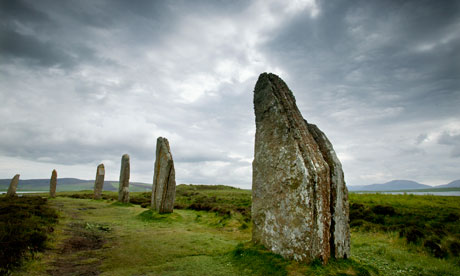Welcome to DU!
The truly grassroots left-of-center political community where regular people, not algorithms, drive the discussions and set the standards.
Join the community:
Create a free account
Support DU (and get rid of ads!):
Become a Star Member
Latest Breaking News
General Discussion
The DU Lounge
All Forums
Issue Forums
Culture Forums
Alliance Forums
Region Forums
Support Forums
Help & Search
Anthropology
Related: About this forumArchaeologists and pagans alike glory in the Brodgar complex
http://www.guardian.co.uk/commentisfree/belief/2012/jan/31/archaeologists-pagans-brodgar-complex
The Ring of Brodgar ancient standing stones in Orkney, Scotland, flank the Brodgar complex, now thought to be older than Stonehenge. Photograph: Murdo Macleod
Archaeologists are notoriously nervous of attributing ritual significance to anything (the old joke used to be that if you found an artefact and couldn't identify it, it had to have ritual significance), yet they still like to do so whenever possible. I used to work on a site in the mid-1980s – a hill fort in Gloucestershire – where items of potential religious note occasionally turned up (a horse skull buried at the entrance, for example) and this was always cause for some excitement, and also some gnashing of teeth at the prospect of other people who weren't archaeologists getting excited about it ("And now I suppose we'll have druids turning up"
The Brodgar complex has, however, got everyone excited. It ticks all the boxes that make archaeologists, other academics, lay historians and pagans jump up and down. Its age is significant: it's around 800 years older than Stonehenge (although lately, having had to do some research into ancient Britain, I've been exercised by just how widely dates for sites vary, so perhaps some caution is called for). Pottery found at Stonehenge apparently originated in Orkney, or was modelled on pottery that did.
The site at the Ness of Brodgar – a narrow strip of land between the existing Stone Age sites of Maeshowe and the Ring of Brodgar – is massive: the size of five football pitches and circled by a 10ft wall. Only a small percentage of it has been investigated; it is being called a "temple complex", and researchers seem to think that it is a passage complex – for instance, one in which bones are carried through and successively stripped (there is a firepit across one of the doors, and various entrances, plus alcoves like those in a passage grave, which are being regarded as evidence for this theory – but it's a bit tenuous at present). Obviously, at this relatively early stage, it's difficult for either professional archaeologists or their followers to formulate too many firm theories.
When it comes to the pagan community, I don't think that its sounder members will be leaping to too many conclusions too soon; as discussed in a previous column, some of us would prefer to rely on the actual evidence rather than rushing off at a tangent. I cannot help wondering whether the relatively muted response across the pagan scene to the Brodgar findings has to do with the fact that the central artefact discovered so far – the "Brodgar Boy" – is apparently male rather than female. I am cynical enough to wonder whether, if it had been a northern Venus, there would be much more in the way of rash speculation about ancient matriarchies. Will we see the pagan community flocking to Orkney at the solstices? I doubt it. Orkney is a long way off and rather difficult to get to, whereas Stonehenge and Avebury are with a reasonably easy drive if you happen to live in the south of the country. In the days when the site was at its peak, most traffic would have been coastal, and remained so for hundreds of years to come. (And to be fair, many modern pagans aren't actually too keen on trampling over ancient sites, sacred or otherwise, due to awareness of their relative fragility)
InfoView thread info, including edit history
TrashPut this thread in your Trash Can (My DU » Trash Can)
BookmarkAdd this thread to your Bookmarks (My DU » Bookmarks)
0 replies, 1215 views
ShareGet links to this post and/or share on social media
AlertAlert this post for a rule violation
PowersThere are no powers you can use on this post
EditCannot edit other people's posts
ReplyReply to this post
EditCannot edit other people's posts
Rec (6)
ReplyReply to this post